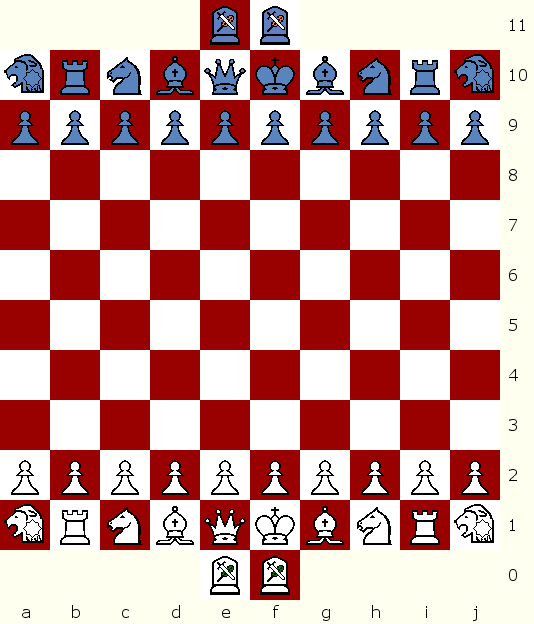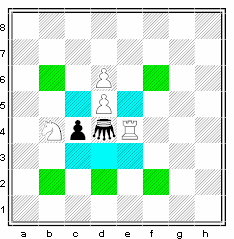Insane Ninja Chess
Derived from the sub-variant: Birds and Leaping Ninjas, Insane Ninja Chess uses the same unique board and rules from this family of games. Instead of the flying bombers, this variant features a pair of the very exciting and powerful Insane Ninjas.The main characteristics of this game are a large 10x10 board with 4 protruding squares from each side's backrank, flexible castling, logically extended en-passant rules and initial pawn move. Except for these and the two new pieces, the game is identical to orthodox chess.
There are two games contained in this title. The main variation uses board setup #1 and a pair of Leaping Ninja Guards housed in the two extra squares.The second game uses setup #2 and houses the Insane Ninjas in the two back squares instead of at the wings. The leaping guards are replaced by regular ninja guards - the same pieces without the camel's leaping move.
The insane ninja is a modified compound consisting of the
basic building blocks Ferz, Alfil, Dabbabah and Wazir.
Similarly, the ninja guard is a modified compound consisting of the Ferz and Alfil. Adding the camel's move results in the Leaping Ninja Guard.
Setup
Board Setup #1
 |
Start Position for white. (black mirrors white)
Insane Ninjas on a1,j1 Rooks on b1,i1 knights on c1,h1 bishops on d1, g1 queen on e1 king on f1 leaping ninja guards on e0,f0 pawns from a2-j2 |
Insane Ninja Chess Board Setup #2
In this setup, the ninja guards replace the leaping ninja guards. (There is no leaping camel move for these pieces).
Pieces
The Mad Leaping Ninja Guard’s Moves
The Leaping Ninja Guard is a color bound piece with three modes of movement and two capture modes.-
Movement:
- Move one step diagonally
- Leap two steps diagonally
- Leap an extended knight's leap i.e. three horizontal/vertical and one square perpendicular (3,1 leap).
-
Capturing
- It can capture on any square it lands just like a normal chess piece
- Capture by jumping over an enemy piece that is diagonally adjacent to it.
Note: that it can only do this type of capture when carrying out the 2 square diagonal leaping movement. - It can combine both capture modes to capture two pieces, the first immediately adjacent to it, and the next right after, in its path on a diagonal by jumping over the first one and capturing the second piece on the square it lands.
Note that the leaping ninja guard can only capture one piece on the square it lands if performing the extended knight 3,1 jump move or if moving one step diagonally.
 |
The Ninja Guard on d5 can capture all the pieces in the diagram. It can also jump to the squares in red, or
move to any square that is 1 step away diagonally that is not occupied by a friendly piece.
It can capture the pawn on c4 by moving to that square or capture both pawns on c4 and b3 by jumping to b3. It can capture the knight on f7 by jumping over the pawn at e6. It can capture the rook at e4 by moving to e4 or leaping to f3. |
The Insane Ninja’s Moves
The Insane Ninja possesses both dual mode movement and dual mode capture capabilities.-
Movement:
- move one step in any direction (diagonally or orthogonally)
- Leap two steps in any direction (diagonally or orthogonally).
-
Capturing
- It can capture on any square it lands as normal pieces do.
- It can capturing any adjacent piece (orthogonally or diagonally) by jumping over it.
- Combine both capturing modes to capture two pieces (the first immediately adjacent to it, and the next right after) on any orthogonal or diagonal line by jumping over the first one and the capturing the second piece on the square it lands.
 |
The Insane Ninja on d4 can capture all the pieces in the diagram.
It can also move to the squares in blue or the squares in green by leaping.
It can capture the pawn on d5 by moving to that square or capture both pawns on d5 and d6 by jumping to d6. It can capture the knight on b4 by jumping over the pawn at c4. It can capture the rook at e4 by moving to e4 or leaping to f4. Note that it must capture the rook if it jumps to f4. (Capturing is mandatory). |
Rules
The rules are as in orthodox chess except as noted below:-
Pawn moves: A pawn situated on the lower half of the board can at any time move forward 1-3 vacant squares to reach the center of the board (rank 5 for white, rank 6 for black). Once the pawn reaches the center row, it can move forward only one square at a time.
Some examples: The white pawn at f2 can start f2-f5 or it can move f2-f4 then f4-f5, or f2-f3 followed by f3-f5, or move f2-g3 to capture enemy piece at g3 followed by g3-g5 next time it moves. - En Passant: If a Pawn moves two or three squares initially and passes an opposing Pawn on the fourth or fifth rank, the Pawn may be captured en passant. E.g. White pawn on a2 black pawn on b4. If the white pawn moves from a2 to a4 or a5, the black pawn on b4 can capture it as if it had moved to a3. Similarly, if the black pawn is on b5 instead and the white pawn moves to a5 from a2 then the black pawn can capture the white pawn as if it moved to a4. Note in this case the white pawn can still avoid the black pawn by moving to a3 instead.
If a pawn slides forward 2 squares on its second move, it can also be captured en passant by an opposing pawn on the fifth rank. E.g. white pawn on a3 and black pawn on b5. White plays a3-a5, black pawn on b5 can capture the pawn en passant by moving to a4.
Capturing en passant is optional unless it is the only legal move available. The capture must be made on the next move. - Pawn promotion: Pawns must promote to: queen, bishop, knight, rook, leaping ninja guard or insane ninja on the 10th rank (Rank 10 for White, 1 for black).
-
Castling:
The usual castling criteria apply: No piece must be in between the spaces travelled by the king and castling rook, cannot castle out of check,
King cannot pass over or land on squares attacked by enemy, but rook can.
There are 7 possible castling positions: The choice of castling positions will depend on whether it is immediately necessary for the king to be nearer the wing or for the rook to be centralized. Note that the rook must always be next to the king after castling. The exact positions below are for board setup #1.-
1 space transposition - King Side Castling
White moves King one space from f1-g1 and rook from i1-f1
Black moves King one space from f10-g10 and rook from i10-f10 -
1 space transposition - Queen Side Castling
White moves King one space from f1-e1 and rook from b1-f1
Black moves King one space from f10-e10 and rook from b10-f10 -
2 space transposition - King Side Castling
White moves King two spaces from f1-h1 and rook from i1-g1
Black moves King two spaces from f10-h10 and rook from i10-g10 -
2 space transposition - Queen Side Castling
White moves King two spaces from f1-d1 and rook from b1-e1
Black moves King two spaces from f10-d10 and rook from b10-e10 -
3 space transposition - King Side Castling
White moves King three spaces from f1-i1 and rook from i1-h1
Black moves King three spaces from f10-i10 and rook from i10-h10 -
3 space transposition - Queen Side Castling
White moves King three spaces from f1-c1 and rook from b1-d1
Black moves King three spaces from f10-c10 and rook from b10-d10 -
4 space transposition - Queen Side Castling
White moves King four spaces from f1-b1 and rook from b1-c1
Black moves King four spaces from f10-b10 and rook from b10-c10
-
1 space transposition - King Side Castling
Optional Rule: Ninja Pawn Drops
This subvariation adds an exciting twist to the gameThe ninja pawn possesses slightly different modes of movement and capture depending on which half of the board it is on.
Dropping:
The ninja pawn is not present at the start at the game and is dropped by the player into the drop zone, which are each side's 2nd rank squares. For example, the drop zone for white is from a2-j2 and for black from a9-j9.
The square must be vacant to drop the pawn. You can optionally move the pawn forward towards the center on the same move but you cannot make a capture on the same move as the drop. You can however drop a pawn to check or to checkmate the opposing king
A maximum of 4 ninja pawns can be dropped by each side during a game.
Movement:
The ninja pawn can always move 1 square up or 1 square sideways to an empty square from any part of the board.
Once it passes the middle, the ninja pawn can only move 1 square forward at a time, or move 1 square horizontally.
Capture:
Like the standard pawn it can capture one square diagonally up, regardless of which half of the board it is on.
When the ninja pawn is on the top half of board (White rank 6 +, Black rank 5-) , it can also capture one square horizontally.
There is no en passant. It cannot capture another pawn or ninja pawn en passant nor can any other pawn capture it this way.
Promotion: The ninja pawn promotes on the last row (rank 10 for white, rank 1 for black), to any piece. Promotion to a piece is mandatory so it would cease to be a pawn in the last row.
Notes
- The original start position has very similar weak points as the 8x8 standard chess game. For example the pawns g2 or g9 are protected only by their respective kings.
- The center pawns free the bishops just like in standard chess. And, instead of the knights, the leaping ninja guards attack the center pawns. For example, f2-f5 f9-f6 white can play f0-g3 . Later white can play g1-c5 striking at black's weak point.
- The insane ninja is very powerful especially in the endgame and it can easily checkmate the enemy king with the aid of its king.
In contrast, while the leaping ninja guard can be quite powerful in the opening and middle stages of the game, it cannot force the checkmate of the opposite king with the aid of its king. - The insane ninja may be worth slightly more than the rook, while the leaping ninja guard probably ranges from a little less to a little more than the power of the bishop.
 This 'user submitted' page is a collaboration between the posting user and the Chess Variant Pages. Registered contributors to the Chess Variant Pages have the ability to post their own works, subject to review and editing by the Chess Variant Pages Editorial Staff.
This 'user submitted' page is a collaboration between the posting user and the Chess Variant Pages. Registered contributors to the Chess Variant Pages have the ability to post their own works, subject to review and editing by the Chess Variant Pages Editorial Staff.
By Charles Daniel.
Web page created: 2007-12-29. Web page last updated: 2007-12-29
